
At the 68th World Summit on the Condition of Women (CSW68), bioethicist Giulia Bovassi raised awareness within the United Nations about the challenges associated with surrogate motherhood. These challenges impact both the woman acting as a surrogate and the unborn child, who is intentionally conceived and planned generally for commercial purposes.
During this summit, Dr. Bovassi engaged in a secular reflection deeply grounded in factual reality. One of the pivotal questions she posed was: “Where is the mother?” This inquiry delves into the heart of the matter, highlighting the complex dynamics surrounding surrogacy and its implications for maternal identity and the well-being of the child.
“If the body, from being inalienable and inviolable, becomes a biological resource, within the reproductive sphere the gift undergoes transformation into a commercial product, when, on the contrary, the category of gift stands in stark contrast to performance and dynamics of remuneration/reimbursement. In surrogacy, there is an economistic use of the solidaristic experience and the solidaristic principle loses validity when there is a risk of instrumentalization of the self.”
The speech explains how economicist logic leads from the unavailability of the human body, into its total provision and availability, particularly during pregnancy.
“Consent is not sufficient to make an action a morally good act, nor it is sufficient to legitimize it. Consensus-based justificationism builds misleading traps of compassion and solidarity since there is no altruism in a commercial exchange or donation when it comes to bodies and human beings, that is, when it comes to someone and not something.”
Dr. Bovassi eloquently highlighted the violence and injustice faced by so-called “carrier” women. Their freedom is tightly controlled during the months of pregnancy. Even in the emotional realm, they are forced not to create emotional bonds with the unborn child growing in their womb. In surrogacy it almost seems as if there is no biological interaction between the two bodies – the mother and the baby – despite scientific evidence to the contrary.
“The child is problematized in surrogacy: first as obstacle, then as desire/need/possession, finally as genetically and technically idealized project, for whose responsibility (of being as he is) he will be able to hold third parties accountable (even in terms of damage).”
According to Dr. Bovassi’s rational reasoning, the child becomes invisible within the surrogate. The child is treated as a product of conception, a purchased object that runs the risk of commodifying even the morality associated with it, since it is subjected to the economy.
“If the origins common to humanity become product, as product we will be tempted to treat ourselves and our neighbor to the exclusion of ethical”
“affirm the universal crime of surrogacy is the only pursuable path in order to contain the temptation to pervert human relations into the Marxian and biologistic dominance of the dominant over the dominated. Law does not establish the good, but recognize, defends and pursues it.”
Giulia Bovassi’s speech concluded by once again posing the question to the Assembly: “Where is the mother?” Her hope is that through seeking this answer, we can collectively reaffirm the importance of filiation and the fundamental relationship between mother and child—the very bond from which all of humanity originates

Bovassi, Giulia,
La maternità come paradigma della condizione femminile,
tra post-femminismo e tecnocrazia,
in “Femininum Ingenium. Collana di studi sul genio femminile”,
Vol.VI, CSFI, Drengo (Roma) 2022

